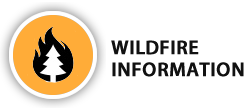Introduction
Post-Fire Treatments: A Primer for New Mexico Communities
In recent years, New Mexico residents have witnessed runoff, flooding, erosion, and debris flow events following severe wildfires. These secondary fire effects can have significant and long lasting impacts to communities, private landowners, and high-value infrastructure. Mitigating these secondary fire effects using post-fire treatments is of great interest to stakeholders affected by severe wildfires.
This guide is designed to provide communities and individuals a primer on the different types of post-fire treatments, as well as a review of their effectiveness as reported in the scientific literature.
After a wildfire, federal, state, and local partners often work together to assess fire impacts and prioritize areas for post-fire treatment. These assessments identify focus areas such as severely burned watersheds, steep slopes, areas where runoff will be excessive, and other values at risk such as infrastructure.
Before implementing any treatments, it is recommended that individuals and communities consult with experts in the post-fire treatment profession who can provide perspective, insight, guidance, and advice in an ever evolving field of practice. Engineers and hydrologists are particularly important when considering any type of in-channel treatment. In some cases, permitting may be necessary before implementing treatments (contact your county permitting department, the U.S. Army Corps of Engineers, and/or the New Mexico Environment Department).
Keep in mind, differing opinions exist about the use and effectiveness of various post-wildfire treatments. It is not uncommon for one practitioner, for example, to have an affinity for a particular treatment based on personal experience, while another’s experience contradicts the firsts. In fact, differing opinions and results are to be expected depending on how and where treatments are implemented as well as post-fire weather. In an attempt to address this circumstance, the authors of this section have based this review on published scientific studies where available (see references). Nonetheless, treatment effectiveness reviews are not intended to discount professional judgment and knowledge of place. Inclusion of treatments in this guide should not be interpreted as an endorsed of its viability or usefulness, but rather a simple accounting of its historic use.
Consider the following anecdotal story from the 2002 Missionary Ridge Fire in Colorado that illustrates how different objectives and experiences may call for different treatments and approaches, and how not all individuals or communities will have the same objectives, approaches, or in some cases financial resources.
“…several hillslope erosion control measures and some channel treatments were installed at higher than normal density above Lemon Dam to protect the intake structures of the dam from being filled with sediment. Since the dam is a critical component of the water supply system for the city of Durango, Colorado, the Water Conservation District was anxious to ensure continuous facility operation (deWolfe and others 2008). The hillslope treatments included: log erosion barriers (LEBs) at 90 to 250 LEBs per acre, 200 to 600 percent of typical; hand-spread and crimped straw mulch at 2.5 tons per acre, 125 percent of typical; and hand-spread seeding at 60 to 75 lbs per acre, 150 percent of typical. In addition, 13 check dams and 3 debris racks were installed in the main drainage channel of the basin. The erosion barriers, check dams, and debris racks were cleaned out and rehabilitated after each sediment-producing storm to ensure maximum performance for the next event. This combination of treatments virtually eliminated sedimentation into the reservoir. The authors attribute the success of this treatment combination to 1) the high density of application for each treatment, 2) the enhancement of treatments working in concert, 3) the quality of treatment installation, and 4) sediment and debris removal from barrier treatments and repair of treatments to extend their useful life (deWolfe and others 2008).” (From Robichaud et al. 2010)
Photo: Example of multiple post-fire treatments: debris basin, slash/mulch spreading, and silt dams.
The authors of this section of the guide hesitated to include a cost estimate for each of the treatments as this information is inherently variable and ever changing from year to year and location to location. However, we included it nonetheless in an attempt to provide some measure of comparison between treatments. Costs estimates came almost exclusively from Burned Area Emergency Response Catalog (2006).
Much of the text for this review comes directly from the following publications: Evaluating the Effectiveness of Postfire Rehabilitation Treatments by Robichaud, Beyers, and Neary (2000); Burned Area Emergency Response Treatments Catalog from the USDA Forest Service (2006); A synthesis of postfire road treatments for BAER teams: methods, treatment effectiveness, and decision making tools for rehabilitation by Foltz, Robichaud, and Rhee (2009); and Post-fire treatment effectiveness for hillslope stabilization by Robichaud, Ashmun, and Sims (2010).
We welcome your comments about this section. To send us a note, click on 'Contact' in the footer of this website.

